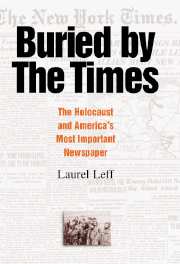Book contents
- Frontmatter
- Dedication
- Contents
- Acknowledgments
- Note Abbreviations
- Introduction: “Last Voice from the Abyss”
- PART I 1933—1941
- 1 “Not a Jewish Problem”: The Publisher's Perspective on the Nazis' Rise and the Refugee Crisis
- 2 “This Here Is Germany”: Reporting from the Berlin Bureau
- 3 “Worthy of France”: The Vichy Government's Anti-Semitic Laws and Concentration Camps
- 4 “A New Life in Nazi-Built Ghettos”: German Domination of Poland, Rumania, and the Baltic States
- PART II 1942—1945
- Conclusion: “The Horrible Story Was Not Told”
- Appendix A Key Individuals
- Appendix B Key Institutions
- Appendix C List of Front-Page Stories
- Notes
- Index
4 - “A New Life in Nazi-Built Ghettos”: German Domination of Poland, Rumania, and the Baltic States
Published online by Cambridge University Press: 05 February 2015
- Frontmatter
- Dedication
- Contents
- Acknowledgments
- Note Abbreviations
- Introduction: “Last Voice from the Abyss”
- PART I 1933—1941
- 1 “Not a Jewish Problem”: The Publisher's Perspective on the Nazis' Rise and the Refugee Crisis
- 2 “This Here Is Germany”: Reporting from the Berlin Bureau
- 3 “Worthy of France”: The Vichy Government's Anti-Semitic Laws and Concentration Camps
- 4 “A New Life in Nazi-Built Ghettos”: German Domination of Poland, Rumania, and the Baltic States
- PART II 1942—1945
- Conclusion: “The Horrible Story Was Not Told”
- Appendix A Key Individuals
- Appendix B Key Institutions
- Appendix C List of Front-Page Stories
- Notes
- Index
Summary
In 1941, Eliahu Elath was in Ankara on a mission for the Political Department of the Jewish Agency, the quasiofficial body representing the Jews living in British-held Palestine. Elath, who had learned much about the perilous position of Jews in occupied Europe, wanted to relay the news to the American Jewish Congress in New York, but feared he could not rely on the usual channels. Strict British military and political censorship might block its transmission, and the Turkish censor could strike such information in mail from Ankara to the United States. Elath decided to turn to the New York Times for help.
Knowing that each evening the Times transmitted the daily news over state radio to the Times offices in New York, Elath believed he could devise a code that would enable him to relay information embedded in the regular broadcast. He would need the help of a Times reporter. He had two choices: Ray Brock, the Times regular Ankara correspondent and a non-Jew whom Elath barely knew, or Cyrus Sulzberger, the Times roving foreign correspondent, nephew of the publisher, and a Jew whom he knew fairly well. Elath chose Brock rather than ask for help “from an assimilated and anti-Zionist Jew, who was a member of the paper's establishment as well.” Brock agreed to use Elath's code during his broadcasts. “All this was done without [Brock's] superiors in New York knowing about the arrangement between us,” Elath recalled years later. “He realized the importance of the matter for our cause and decided to chance all the risks involved.”
- Type
- Chapter
- Information
- Buried by the TimesThe Holocaust and America's Most Important Newspaper, pp. 107 - 132Publisher: Cambridge University PressPrint publication year: 2005



